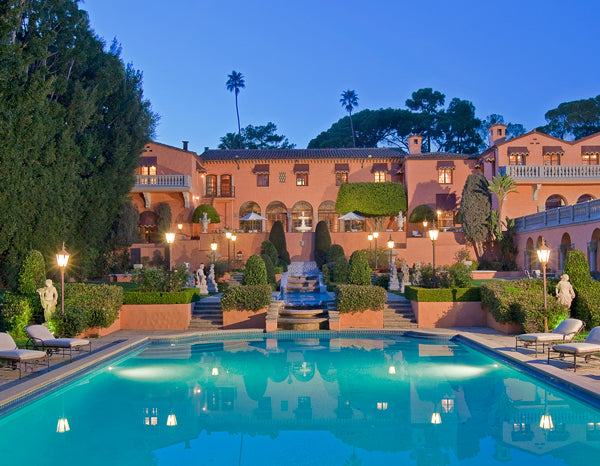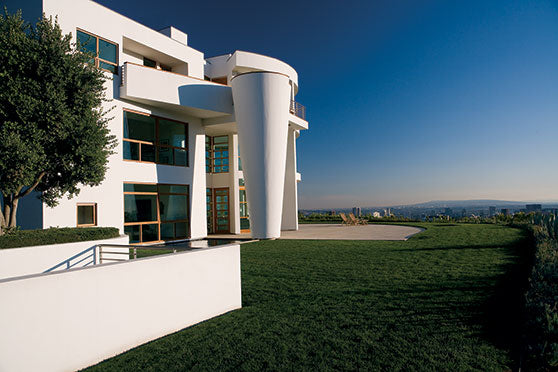THE LEGENDARY ESTATES OF BEVERLY HILLS
EXCERPTS

By any measure – size, cost, or boldness of vision – Greystone was the grandest estate ever completed in Southern California. The fifty-five room, 46,000 square-foot mansion sat on a lofty knoll at 501 Doheny Road, high above the estates of the mere millionaires on Sunset Boulevard and Lexington Road. It had cost an astounding $4 million upon its 1929 completion, which would have purchased dozens of large homes in the Beverly Hills flats below Sunset Boulevard.
The Tudor-style mansion was the centerpiece of the 429-acre Doheny Ranch, which stretched from Doheny Road far up into the hills. Greystone and its immediate grounds could be seen from miles away.
The impressive – indeed, forbidding – Greystone was more than an unmistakable emblem of the Doheny family’s unrivalled wealth and authority, which was anchored in Southern California and extended to the national level. The estate’s sheer size and its cost also symbolized the rough-and-tumble world of the early 20th century oil industry in which the Doheny family had made its vast fortune. Then, in 1929, the estate became a crime scene in one of Los Angeles’ most talked about, and most misunderstood, murders. To this day, the estate is wrapped in layers of mystery. It is even said to be haunted by the ghosts left behind in an era of misdeeds.
By the early 1920s, Doheny Senior had decided that Ned should build a mansion on the family ranch. He set aside twenty-two acres at the southern end of the property for the residence and grounds.
While Greystone’s exterior was grand, the interior was given a pleasing sense of proportion combined with careful craftsmanship, a sense of stateliness, and wealth. The front entrance – a set of plate-glass doors decorated with elaborate hand-wrought iron grillwork – opened onto a marble stair landing. At the right were marble stairs to the second floor. Ahead was a grand marble staircase that led down to the first-floor hallway, which ran perpendicular to the main stairway for the length of the building. At the bottom of the grand staircase was a set of carved and polished oak archways that led into a marble-floor reception room with a fountain. Beyond, through arched French doors, was a terrace with sweeping views of the immense, steeply sloped lawn and the entire Los Angeles basin.
But this psychic phenomenon does not seem to be the ghost of either Ned Doheny or Hugh Plunkett who both died so mysteriously in the mansion. Rather, the strange sound that has been heard seems to be that of a woman, weeping inconsolably. Perhaps it is the spirit of a young Lucy Doheny mourning her dead husband, or her family, which rose so high in the world only to be brought down by bold over-reaching and by scandal.

The world of William Randolph Hearst and Marion Davies was one of extravagant mansions, dazzling parties, celebrity friends and hangers-on, and million-dollar shopping trips to Europe, all bound together by a genuine love. Their affair lasted thirty-four years, ending only with Hearst’s death in 1951.
In 1919, Hearst and Marion moved to California, where they lived openly together, a deliciously scandalous choice that provided decades of fodder for newspapers and magazines in competition with Hearst’s empire. The mansion at 1700 Lexington Road was the first in a series of lavish Beverly Hills homes. He already owns a luxurious lodge, Wyntoon, designed by architect Julia Morgan, in northern California, near the Oregon border. But all these homes were not enough for their life together.
Hearst wrote Morgan to discuss the 270,000 acres he owned in San Simeon, 250 miles north of Los Angeles, where he had often gone camping with family and friends. That “little something” would become a 165-room castle with outbuildings and 127 acres of grounds. Hearst filled the castle with architectural details; even whole ceilings and invaluable antiques including ancient Greek vases, rare oriental carpet, and tapestries. Among the thousands of works of art were sculptures and paintings by Albrecht Durer and William Hogarth.
Under the terms of Marion’s will, Captain Brown was given a trust fund that would provide a $3,000 monthly allowance, and he was allowed to live in the Beverly House for the rest of his life. Brown frequently rented the property as a film location and he sometimes played bit roles, but by the mid-1960s, he realized that he could not afford the estate’s upkeep.
The trustees of Marion’s estate faced a decision: what to do with the now-empty. Marion had sold some of the lower land (namely the stables, pools, and orchards) along North Beverly Drive as home sites during the 1950s, but the property still had three and one eighth acres on the hilltop. Great estates and classic 1920s mansions, however, were considered to be an anachronism by this era, which favored “ranch houses” and cars with tail fins. The Beverly House, in other words, was a white elephant at great risk of demolition.
In 1966, the trustees offered the property to the City of Beverly Hills, as a park. The City said no, because it was paying off the earlier $1.1 million purchase of the Doheny family’s Greystone. The mayor indicated that the City would accept the estate as a donation. The trustees said no.
In 1967, a Beverly Hills resident purchases the estate. The price? $1.5 million. Nine years later, it transferred again. Captain Brown’s family was delighted that the estate would be preserved, and they donated one of Marion’s larger-than-life portraits from her 1920s heyday as a gift.
Throughout the 1990s and the early years of the 21st century, 20,000 square feet were added to the mansion, and substantial improvements were made to the grounds. The portrait of Marion Davies hangs in the billiards room; a lovely reminder of this grand estate’s storied past.

During the golden age of Hollywood – which ran from the late 1920s to the advent of television and the disintegration of the studio system in the early 1950s – movie studio czars lived in impressive mansions set amidst handsome gardens to flaunt their wealth and power and to hold highly publicized parties with hundreds of guests.
No studio czar’s residence, before or since, has ever surpassed in size, grandeur, or sheer glamour than the Jack Warner Estate on Angelo Drive in Benedict Canyon.
In a supreme show of confidence – or ego – Warner didn’t emulate English aristocracy or fading silent-movie stars like Douglas Fairbanks Senior and Mary Pickford by giving his estate an impressive-sounding name. His own name – Jack Warner – was impressive enough.
Warner also took a very different approach to building his estate. Most movie stars and studio executives constructed their grand estates all at once. Warner, however, created his Angelo Drive estate step-by-step over a decade. His home grew and changed as his business and personal life grew and changed.
By now, it’s a cliché to say that the various studio heads during the Golden Age of Hollywood were all larger-than-life characters, whose talent – or perceived lack of same – has been endlessly lampooned in widely circulated anecdotes ad stories. When these stories are boiled down the results tend to establish a ranking among the moguls. David O. Selznick, Sam Goldwyn, Harry Cohn, and Darryl F. Zanuck might have been quirky and obsessive, but they received a certain respect as filmmakers. Louis B. Mayer, “Uncle” Carl Laemmle Senior, and Jesse Lasky might not have been the greatest filmmakers, but they were showmen: executives who managed the rough-and-tumble film factories that were Hollywood in its glory days. So on down the list. And then there was Jack Warner.
Greystone was the grandest estate ever completed in Southern California. Build by oilman Edward Laurence Doheny, Jr., The 55-room, 46,000 square-foot mansion and its extensive gardens cost an astounding $4 million dollars upon its 1929 completion.
Burton E. Green was the father of Beverly Hills. As President of the Rodeo Land and Water Company, this oil millionaire-turned developer transformed acres of dusty bean fields into a fashionable community of large homes on gentrly curving tree-lined streets. Green built his own showplace mansion on a picturesque knoll behind the Beverly Hills Hotel.
This Italian Renaissance mansion is one of the most distinctive -- and most storied -- homes in Bel-Air. This curved 180-foot-long mansion, designed by famed architect Wallace Neff, stands on a knoll well back from Bellagio Road, east of Stone Canyon and overlooks the Bel-Air Country Club on the other side of the street. The main rooms open onto expansive terraces, and majestic staircases lead down to the pool and gardens.
Some of the greatest estates are showcases of contemporary design. This Bel-Air estate occupies one of the most dramatic sites in Bel-Air: a flat promontory with views stretching over West Los Angeles to the Pacific Ocean.
This estate is a masterpiece of 1920s design. The mansion, designed by Santa Barbara architect George Washington Smith, is a restrained yet unabashedly romantic expression of the Spanish Colonial Revival that was so popular in Southern California during the 1920s.
The era of great new estates in Beverly Hills, Holmby Hills, and Bel-Air is over. Or so some skeptics claim. Nobody can purchase enough flat or gently rolling land in those legendary neighborhoods. Skilled craftsmen cannot be found at any price. For once, the naysayers are wrong. Very wrong.
In the early 1920s, one romantic star shone brighter than any other. Women fans tried to speak onto his movie sets. A few managed to climb over the walls of his Beverly Hills estate in search of their idol. The star was Rudolph Valentino, and his estate was Falcon Lair. Valentino extravagantly filled Falcon Lair with art and antiques, and he owned many fine cars, including a custom-made 1926 Isotta Fraschini limousine.












